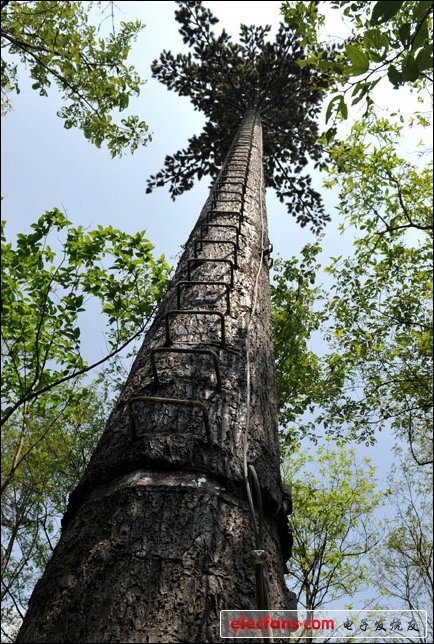Wuhan's wireless city is getting larger and larger, with the increase in the number of signal base stations and the increasing coverage of wireless networks. While WiFi has provided more convenience to the public, many people began to worry about the electromagnetic radiation of the base station. "The base station has been repaired at the doorstep. A large base station is afraid that its radiation will affect the health of the body." The public said. So, how much radiation does the signal base station have? Will it endanger our health?

The signal base station WiFi radiation is only one fifth of the mobile phone?
Recently, a third-party monitoring agency came to Wuhan to actually measure the radiation of the base station here. The data shows that the radiation of the signal base station complies with the national standard, and the value is only 1/5 of the radiation value of the mobile phone during the call. In theory, it will never harm the citizens ’body health.
The monitoring record records that the working group came to the base station of Wuhan Citizen's Home, and the monitoring instruments obtained more than 20 sets of monitoring values ​​at different positions and different distances of the base station. The data shows that the base station radiation value is 0.57-1.46 volts per meter, with an average value of about 0.89 volts per meter. Compared with the 4.5-volt radiation per meter when the mobile phone is monitored on the spot, it is only 1/5 of the radiation when answering the phone. Subsequently, the instrument showed that the base station on the roof of Zhuyeshan Chuangye Building radiated about 1.79 volts per meter.
It is understood that China's standard on electromagnetic radiation requires that the electric field strength should be less than 12 volts per meter, or the power density should be less than 40 microwatts per square centimeter. The above measured data indicate that the electromagnetic radiation of the signal base station is far lower than the national standard. It is reported that the European Union's standard for electromagnetic radiation is less than 450 microwatts, and the standards for Japan and the United States are less than 600 microwatts. In comparison, the national standard for radiation in China is more stringent.
Take a deep breath, close your eyes, the world has the freshest oxygen ... Yu Quan's "Deep Breath" is well known to us, but as the environmental problems become more and more serious, the haze sky also increases, PM2.5 PM10 and so on Vocabulary has also been mentioned more and more, and air purifiers have quickly become popular on the market with this "air quality" trend. Along with this, the air-clean brand has sprung up, and various technologies are dazzling. Which ones are indeed effective and which are just tasteless propaganda? How does the Air Purifier bother us to get rid of pollution? And look at the editors for you.
Analysis of air purifier
The critical value of PM2.5 content is 75 μg / m3
The pollutants in the air mainly include soot, total suspended particulates, inhalable particulates (PM2.5) and fine particulates (PM10). The smaller the diameter of the particulates, the deeper the part that can enter the respiratory tract. 10 micron diameter particles It is deposited in the upper respiratory tract, and particles below 2 microns can penetrate 100% into the bronchiole and alveoli.
1k-5k air purifier prices vary greatly
The air purifier products on the market not only have various functions, but also have prices ranging from thousand yuan to tens of thousands. The pricing of imported products is generally higher than that of domestic brands. Except for the core technology of many brands, the promotion of purification effects is similar, and consumers need to choose according to demand.
The air quality standard of 74 key cities is only 4.1%
According to the data of the press conference held by the State Council Information Office on June 4, according to the new "Ambient Air Quality Standards", the six pollutants SO2, NO2, PM10, PM2.5, CO and O3 were evaluated, 74 new standards In the first phase of monitoring and implementation, the proportion of cities that met the ambient air quality standards was only 4.1%, and the other 256 cities implemented the old air quality standards, and the proportion of cities that met the standards was 69.5%.
Air purifier sales increased by 90.5% compared with last year
According to a report recently released by the China Electronics and Information Industry Development Institute, due to the haze weather, air purifiers have become the most concerned home appliance products, with sales of nearly 2.4 million units nationwide last year, a year-on-year increase of 90.5%; retail The amount reached 5.6 billion yuan, a year-on-year increase of 105.9%.
HEPA filter needs to be replaced in March
The filter of the air purifier is the same as the filter of the water purifier, and it is not effective for a long time. After long-term use, the accumulation of dust on the surface of the filter will also cause the filter to gradually fail. Therefore, when the haze is more serious, the non-washable HEPA filter needs to be replaced every three months.
Merchants claim that the purification rate is more than 99% for the concept of stealing
99% or even 99.99% seems to have become a slogan for many air purifiers on the market. Many brands of products promote their high removal rate of PM2.5 and formaldehyde. In fact, this kind of publicity is more of a kind. The slogan of stealing the concept, the removal rate of 99% is the effect of the material itself on PM2.5 and formaldehyde, not the effect of actually running in space.
Air Purifier
Air Cleaner For Parents,Air Cleaner Office Use,Air Purifier With Negative Ion,Air Purifier
Ningbo Zhe Kai Electric Appliance Co.,Ltd , https://www.cnairpurifiers.com
